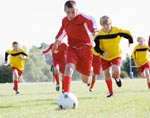
Soccer Injury Prevention
Approximately 231,447 athletes were treated in hospital emergency rooms for soccer-related injuries in 2012, according to the US Consumer Product Safety Commission.
Common Soccer Injuries
Already the most popular international team sport, soccer continues to gain popularity in the United States. With more people playing soccer, it is not surprising that the number of soccer-related injuries is increasing — particularly as children get older and their level of play intensifies.
Sprains and strains, often around the knee and ankle, are very common in soccer. Player collisions — either full body or kick collisions — can cause a wide range of injuries, including cuts, bruises, and concussions. Overuse injuries, such as Achilles tendinitis and shin splints, frequently occur, as well.
Several strategies can help prevent soccer injuries — from careful inspection of the field to wearing proper shin guards.
Proper Preparation for Play- Maintain fitness. Be sure you are in good physical condition at the start of soccer season. During the off-season, stick to a balanced fitness program that incorporates aerobic exercise, strength training, and flexibility. If you are out of shape at the start of the season, gradually increase your activity level and slowly build back up to a higher fitness level.
- Warm up and stretch. Always take time to warm up and stretch, especially your hips, knees, thighs and calves. Research studies have shown that cold muscles are more prone to injury. Warm up with jumping jacks, stationary cycling or running or walking in place for 3 to 5 minutes. Then slowly and gently stretch, holding each stretch for 30 seconds.
- Cool down and stretch. Stretching at the end of practice is too often neglected because of busy schedules. Stretching can help reduce muscle soreness and keep muscles long and flexible. Be sure to stretch after each training practice to reduce your risk for injury.
- Hydrate. Even mild levels of dehydration can hurt athletic performance. If you have not had enough fluids, your body will not be able to effectively cool itself through sweat and evaporation. A general recommendation is to drink 24 ounces of non-caffeinated fluid 2 hours before exercise. Drinking an additional 8 ounces of water or sports drink right before exercise is also helpful. While you are exercising, break for an 8 oz. cup of water every 20 minutes.
- Wear shin guards to help protect your lower legs. Soccer tournament records show that lower leg injuries are most often caused by inadequate shin guards.
- Wear shoes with molded cleats or ribbed soles. Shoes with screw-in cleats often are associated with a higher risk of injury. However, shoes with screw-in cleats should be worn when more traction is needed, such as on a wet field with high grass.
- Use synthetic, nonabsorbent balls on wet playing fields. Leather balls can become water-logged and very heavy when wet, putting players at high risk for injury.
- Soccer goals should be well padded and properly secured. Padding the goal decreases the incidence of head injuries when the goalie and other team members collide with the posts.
- The playing surface must be kept in good condition. Holes on the playing field should be filled, bare spots reseeded, and debris removed.
- Secure the goals at the end of play. A simple bicycle lock can chain the goals together and prevent them from tipping over. Unsecured, unsupervised soccer goals can fall onto children and result in severe injuries.
- Pay attention to the weather conditions: In a thunderstorm, leave the field and get inside immediately. In hot weather, take sufficient water breaks. In cold weather, wear appropriate clothing, including gloves and hats. Consider shortening practices in severe temperature extremes.
- Do not crawl under or sit on the goal, or hang from the net. Injuries and deaths have occurred when goals have fallen onto players.
- Coaches should be knowledgeable about first aid and be able to administer it for minor injuries, such as facial cuts, bruises, or minor strains and sprains.
- If playing on artificial grass fields, make sure to adequately clean any skin scrapes or abrasions to reduce the chance of them getting infected.
- Be prepared for emergencies. All coaches should have a plan to reach medical personnel for help with more significant injuries such as concussions, dislocations, contusions, sprains, abrasions, and fractures.
An injured player's symptoms must be completely gone before returning to play. For example:
- In case of a joint problem, the player must have no pain, no swelling, full range of motion, and normal strength.
- In case of concussion, the player must have no symptoms at rest or with exercise, and should be cleared by the appropriate medical provider.
Because many young athletes are focusing on just one sport and are training year-round, doctors are seeing an increase in overuse injuries. The American Academy of Orthopaedic Surgeons has partnered with STOP Sports Injuries to help educate parents, coaches, and athletes about how to prevent overuse injuries. Specific tips to prevent overuse injuries include:
- Limit the number of teams in which your child is playing in one season. Kids who play on more than one team are especially at risk for overuse injuries.
- Do not allow your child to play one sport year round — taking regular breaks and playing other sports is essential to skill development and injury prevention.
Source: http://orthoinfo.aaos.org/topic.cfm?topic=A00187
